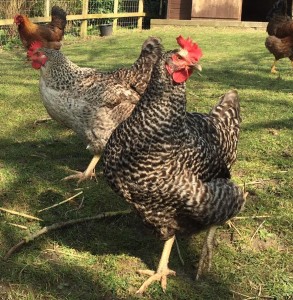News
Archive for May, 2017
Special Offer – June 2017 – Microchip Offer
by admin on May 30th, 2017
Category: Special Offers, Tags:
Mycoplasma in Poultry
by admin on May 30th, 2017
Category: News, Tags:
The ‘Head Cold’ of the Poultry World
As more and more pet owners are keeping poultry we felt it appropriate to look at one of the most common infections that may be seen.
The main culprit of Mycoplasma infection in backyard poultry is Mycoplasma gallisepticum. This is one of the organisms that makes up the colloquially-termed ‘chronic respiratory disease syndrome’ (potentially in association with Infectious Laryngotracheitis) in poultry worldwide. It is considered to be responsible for some of the greatest economic losses throughout commercial flocks around the globe, but can just as easily impact on smaller backyard flocks.
Who catches Mycoplasma, and how?
Poultry, including chickens and turkeys, are most often presented with respiratory issues involving Mycoplasma gallisepticum, but a wide range of other birds including pheasants and wildfowl can be affected.
Mycoplasma gallisepticum can be spread vertically (from hen to egg) leading to infected chicks, or, and perhaps more commonly, through horizontal transmission (bird to bird). The disease can be spread short distances through the air as an aerosol, or on shoes/water drinkers/feeders. The disease itself may remain dormant within the infected bird for potentially months before causing any overt clinical disease. It is often at this stage that rapid spread of the disease occurs throughout a flock.
What does Mycoplasma in poultry look like?
Focusing on the presenting signs of poultry, the degree of clinical signs can vary widely from no apparent signs up to the potential death of the bird in more aggressive, complicated disease development.
The more common presenting signs can include:
- Rales (clicking, rattling, or crackling noises)
- Coughing
- Nasal discharge
- Discharge from around the eyes
- Swelling under the eyes
In more advanced cases, sinusitis may become apparent.
There may also be more generic signs of illness present including the birds appearing fluffed up, off food, keeping themselves away from the rest of the flock and reduction in egg production or going off lay completely.
Clinical signs are often quicker to develop and more severe in turkeys than chickens.
Can Mycoplasma in poultry be treated?
Mild to moderate disease can be treated successfully with appropriate antibiotics prescribed by your vet, pain relief and good nursing management (TLC!). It is important to note however that once your bird/flock has suffered from the disease, it likely to circulate and be present from thereon in. This becomes an important factor when either bringing in new birds or selling/moving your own birds.
Chickens, as well as most other birds, will suffer a much more marked immune ‘crash’ when stressed in comparison to other animals. This means that when birds are moved to a new location or mixed with other birds, the stress can induce a marked reduction in their active immunity causing a rapid onset of disease symptoms (sneezing, coughing, etc.).
Due to the risk of disease spread amongst new birds, it is absolutely vital to quarantine any incoming birds for at least 3-4 weeks to ensure that you are not putting your own birds at risk of disease.
Prevention is better than cure!
Vaccinations are available against certain strains, but use of a vaccine must be with caution as quarantine procedures would still always be advised, and any new birds bought in would have to have been vaccinated. The danger with vaccinating poultry is that all too often it is seen as an easily-achievable blanket cover for disease. Good biosecurity, involving washing boots, is important. Always thoroughly disinfect items that are brought in or taken off the holding containing your particular birds.
Pet of the Month – May 2017 – Bob
by admin on May 1st, 2017
Category: Pet of the Month, Tags:
Bob is one of many cats we attend who suffers from IBD (Inflammatory Bowel Disease).
IBD is not a single disease but a group of chronic gastrointestinal disorders caused by an infiltration of inflammatory cells into the walls of a cat’s gastrointestinal tract. The infiltration of cells thickens the wall of the gastrointestinal tract and disrupts the intestine’s ability to function properly. IBD occurs most often in middle-aged and older cats.
How is IBD diagnosed?
Symptoms of feline IBD are not specific. They may include vomiting, weight loss, diarrhea, lethargy and variable appetite. The symptoms of IBD can vary depending on the area of the digestive tract affected.A definitive diagnosis of feline IBD can only be made based on a microscopical evaluation of tissue collected by means of an intestinal (or gastric) biopsy.
How is IBD treated?
The treatment of IBD usually involves a combination of change in diet and the use of various medications. There is no single best treatment for IBD in cats. Your veterinarian may need to try several different combinations to determine the best therapy for your cat.
Hypoallergenic diets are usually tried first. Corticosteroids like prednisolone may be used to reduce inflammation of the gut. Antibiotics such as metronidazole are commonly used.
What does the future hold for a cat with IBD?
IBD is a chronic disease. Few cats are actually cured. Symptoms of IBD may wax and wane over time. IBD can often be controlled such that affected cats are healthy and comfortable. Vigilant monitoring by the veterinarian and owner is critical.
We are very pleased to report that Bob has responded well to dietary management and is currently not requiring additional medication. Luckily he is not adept at hunting and so we have no fear that he might upset the illness through illicit snacks!
Brachycephalic Obstructive Airway Syndrome (BOAS)
by admin on May 1st, 2017
Category: News, Tags:
‘BAOS: Too much soft tissue and not enough space’
Brachycephalic breeds are those with squashed up faces! We love them and they are great characters but selective breeding over many generations has encouraged the skull to be progressively shorter over time. However, the amount of soft tissue in the nose and throat has remained the same. These soft tissues include the soft palate, turbinates (cartilage inside the nose) and tongue. These are all crammed into a smaller space. In addition, a lack of underlying nasal bones also causes the nostrils to become very narrow appearing like small slits instead of open holes.
Breathing problems
The crowding of this tissue inside the nose and the back of the throat obstructs airflow through the upper airways. This is why many of these dogs are forced to breathe through their mouth and pant. In an attempt to draw air in through this cramped space many affected dogs will put much more effort into their breathing. This is why if you watch these patients closely you will see them using their abdominal muscles as bellows during breathing. A good analogy for this is comparing how difficult it would be to suck through a very narrow straw compared to a normal one.
The ‘knock-on’ effects of laboured breathing
Unfortunately, the increased effort creates a suction effect in the back of the throat at the opening into the trachea (windpipe). This opening into the windpipe is called the larynx (or voice box in people). It has a tough cartilage frame which keeps it open wide. However, constant suction in this region over a period of months can cause it to fold inwards further narrowing the airway and causing serious breathing difficulty. This secondary problem is called laryngeal collapse.
What about the nose?
The nose is an important part of the anatomy and it functions to warm and humidify the air before it is inhaled into the lungs. It is a crucial part of how dogs maintain a normal body temperature. If affected dogs can’t breathe through their nose then this significantly affects their ability to thermoregulate and explains why they have poor heat tolerance. Of course, it is no surprise that many patients present with breathing problems in the summer months.
What are the clinical signs of Brachycephalic Obstructive Airway Syndrome (BOAS)?
The main clinical signs in approximately increasing the order of concern include:
- Loud snoring during sleep
- Noisy breathing (especially during excitement or exercise)
- Panting
- Poor ability to exercise
- Heat intolerance
- Choking on food
- Regurgitating
- Laboured breathing
- Development of blue gums or tongue
- Fainting
Aren’t some of these signs just ‘Normal’ for the breeds?
Yes and no. The problem is that a large number of brachycephalic dogs show the signs at the milder end of the above spectrum and our tolerance of what is normal for these breeds has become skewed. We frequently see patients coming into our clinic for unrelated problems with marked breathing difficulty. When questioned their owners often state that they consider these signs as normal for the breed. They often add that most other dogs of the same breed that they come across on walks sound and react the same which reinforces this notion! Therefore it is important that we get the message across that these signs are abnormal and if your dog is displaying some of them then a veterinary opinion should be sought.
Be proactive!
A proactive approach is beneficial as there are many surgical treatments which can be carried out that will help these patients breathe. Although these treatments will not produce a ‘normal’ airway it will invariably improve airflow, thus improving their quality of life and ability to exercise. The latter is particularly important as obesity makes this problem significantly worse. Intervention early in life can reduce the amount of suction at the back of the throat and therefore reduce or delay the development of secondary laryngeal collapse for which there are limited options available.
See the excellent new film on BAOS by the Kennel Club on Youtube entitled ‘Dog Health: What Is Brachycephalic Obstructive Airway Syndrome?’
Special Offer – May 2017 – Vaccine Amnesty
by admin on May 1st, 2017
Category: Special Offers, Tags:






